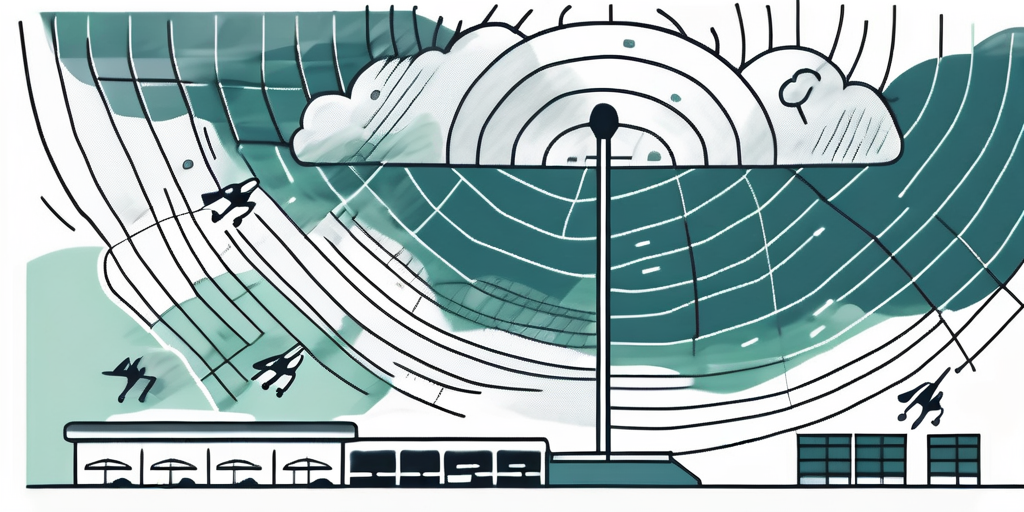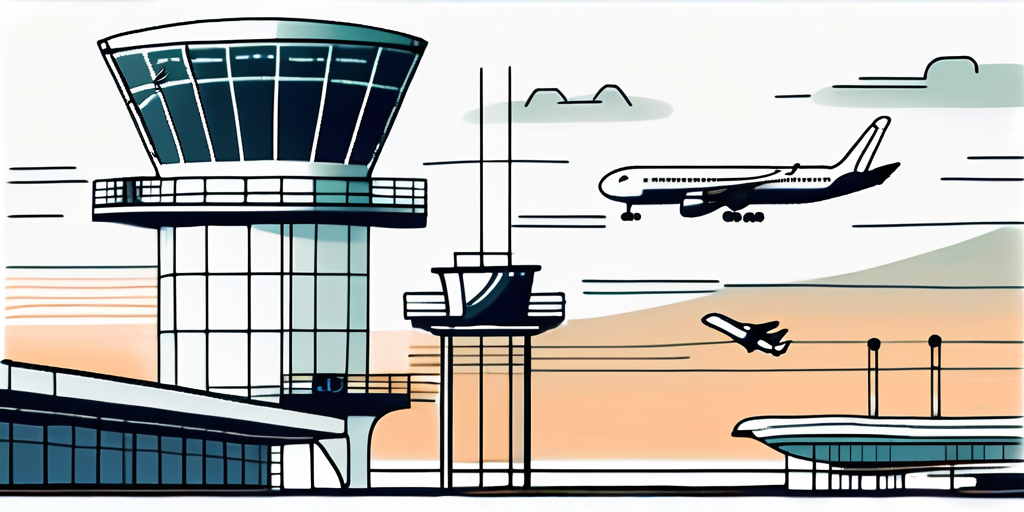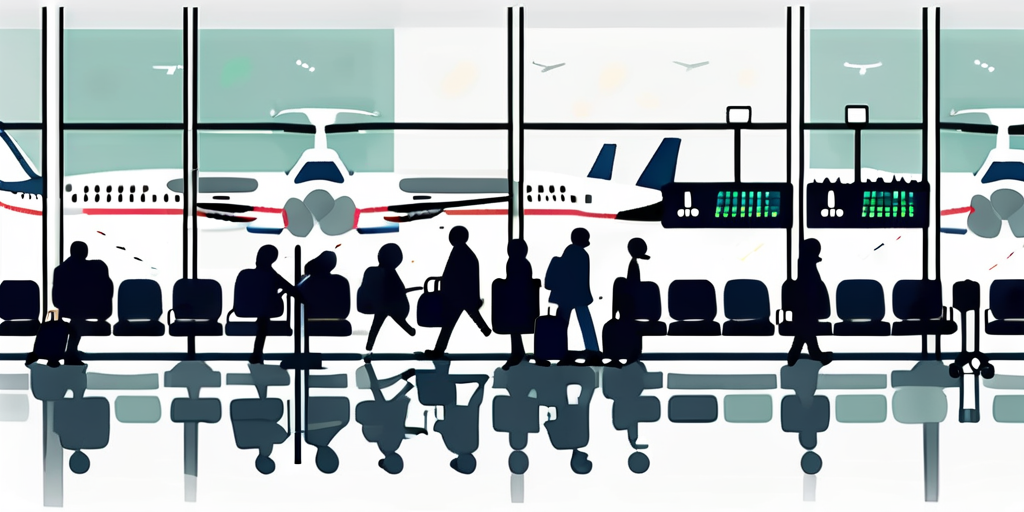How Bad Does Weather Have to Be to Delay a Flight?
Curious about flight delay criteria due to weather? Learn what constitutes "bad" weather and its impact on flight schedules.
Flight delays can be a frustrating and inconvenient experience for travelers. Whether it's a short delay or a longer one, it disrupts travel plans and can cause significant inconveniences. Understanding the factors that contribute to flight delays, particularly those related to weather, can help us better prepare for these situations and alleviate some of the frustrations that come with them.
Understanding Flight Delays
Flight delays can occur for various reasons, ranging from technical issues with the aircraft to air traffic congestion. When it comes to weather-related flight delays, the impact can be substantial. Airlines prioritize passenger safety above all else, and adverse weather conditions have the potential to compromise the safety of the passengers and crew on board.
The Role of Weather in Flight Delays
Weather plays a significant role in flight delays, particularly when it comes to severe weather events such as thunderstorms, heavy snowfall, or strong winds.
According to the 2022 data from the Federal Aviation Administration (FAA) , bad weather represent 75,48% of the delay in the US airspace system, which involve delay going over 15 minutes.
These conditions can make it challenging for aircraft to safely take off or land, necessitating delays to ensure the safety of everyone involved.
During thunderstorms, for example, thunderstorm poses a significant threat to aircraft. According to the FAA,
If a busy jet route becomes blocked by intense thunderstorms, traffic will re-route into the neighboring airspace, which can become overcrowded if the flow is not managed.
Lightning strikes can cause damage to the aircraft's electrical systems, potentially compromising its ability to navigate and communicate. To mitigate this risk, airlines and air traffic control closely monitor weather patterns and make informed decisions to delay flights until the storm passes.
Which Airports Are The Most Impacted By Weather-Related Delay ?
Weather-related delays can impact airports worldwide, but some airports are more prone to weather-related disruptions due to their geographical location, climate patterns, and operational challenges. Here are a few examples of airports that are often affected by weather-related delays:
-
Newark International Airport, USA and LaGuardia International Airport, USA in 2019, two of the biggest airports in New York City have shown more than 66 000 delays going over 15 minutes according to the FAA.
-
Chicago O'Hare International Airport (ORD), USA: Known for its harsh winters and frequent snowstorms, Chicago O'Hare experiences weather-related delays, particularly during the winter months. Snow and ice can disrupt operations and lead to delays, close to 29 000 in 2019 (FAA) and cancellations.
-
San Francisco International Airport (SFO), USA: San Francisco experiences frequent fog, particularly during the summer months, which can affect airport operations. Low visibility due to fog often leads to delays in arrivals and departures, close to 26 000 in 2019 (FAA).
-
London Heathrow Airport (LHR), UK: Fog is a common weather phenomenon at London Heathrow, especially during the autumn and winter months. Dense fog can reduce visibility and impact flight schedules, leading to delays and diversions.
Other Common Causes of Flight Delays
While weather is a common cause of flight delays, it's not the only factor that can impact travel plans. Technical issues with the aircraft, air traffic congestion, or even staffing shortages can also lead to delays. However, weather-related delays are often more challenging to predict and manage compared to other factors.
Air traffic congestion can cause delays), especially at busy airports or during peak travel times. With a limited number of runways and airspace capacity, airports can become overwhelmed with the sheer volume of incoming and outgoing flights. In 2022, close to 15% of the US delays where involving volume issues in the airspace (FAA).
Air traffic control works diligently to manage the flow of aircraft, but sometimes delays are inevitable to maintain safe distances between planes and prevent any potential collisions.
Furthermore, technical issues, such as mechanical problems or malfunctioning equipment, can arise unexpectedly and require immediate attention. According to the 2022's data from the FAA, equipment issues represented only 0,38% of the US Airspace delays.
Airlines have strict maintenance protocols in place to ensure the safety and airworthiness of their aircraft. If a technical issue is detected before takeoff, the airline may need to delay the flight to address the problem and ensure the aircraft is in optimal condition for travel.
Lastly, staffing shortages can also contribute to flight delays. Airlines rely on a complex network of pilots, flight attendants, ground crew, and maintenance personnel to ensure smooth operations. If there is a shortage of available staff, such as pilots or flight attendants, the airline may have to delay or cancel flights until the necessary personnel are available.
The Science Behind Weather-Related Flight Delays
Understanding the science behind weather-related flight delays can shed light on why certain weather conditions can be particularly dangerous for air travel. However, there are even more factors at play that contribute to the complexity of this issue.

The Impact of Wind on Flights
Strong winds, especially crosswinds or gusty winds, can make it difficult for pilots to safely land or take off. These conditions can impact the aircraft's stability and control, posing significant risks during critical moments of flight. To ensure a safe journey, it's crucial for airlines to delay flights when wind conditions exceed the aircraft's operational limits.
But wind doesn't just affect the aircraft itself. It can also affect the air traffic control system. When winds are strong, air traffic controllers may need to adjust the spacing between aircraft to maintain safe separation. This can lead to delays as controllers work to ensure the safety of all flights in the area.
The Dangers of Thunderstorms and Lightning
Thunderstorms bring intense electrical activity, heavy rain, and strong winds. Lightning strikes pose a significant risk to aircraft during flight. To mitigate this risk, airlines closely monitor the development and movement of thunderstorms and may delay flights to avoid flying into areas with active storm cells.
But thunderstorms don't just pose a risk in the air. They can also impact ground operations. Heavy rain can cause flooding on airport runways, making them unsafe for aircraft to land or take off. Additionally, strong winds associated with thunderstorms can damage ground equipment, further delaying flights as repairs are made.
Cases, where passengers were stranded for excessive periods, led the Department of Transportation to pass a rule prohibiting airlines from leaving planes parked for more than 3 hours without allowing passengers to disembark.
(FAA)
The Effect of Snow and Ice on Air Travel
Snow and icy conditions can affect both the runway and the aircraft. Accumulated snow or ice on the runway can reduce traction, making it challenging for aircraft to land or take off safely. Additionally, ice buildup on the aircraft's wings or other critical surfaces can affect aerodynamics, potentially compromising the aircraft's performance. Airlines will often delay flights until snow is cleared and runways are properly de-iced to ensure safe operations.
But snow and ice don't just impact the airport infrastructure. They can also affect the aircraft's fuel efficiency. Cold temperatures can increase fuel consumption, requiring additional time for refueling before a flight can depart. This, coupled with the need for de-icing, can lead to longer delays as airlines work to ensure the safety and efficiency of their operations.
If your flight has been delayed due to bad weather conditions, you might be entitled to compensation.
With our free flight delay compensation calculator, learn whether you're eligible for compensation and how much the airline may owe you, in just 2 minutes.
How Airlines Determine Flight Delays And How To Prevent It
When it comes to making decisions about flight delays, airlines consider several key factors, including weather forecasts, safety protocols, and regulations.

Weather Forecasting and Flight Planning
Airlines rely on meteorological reports and forecasts to anticipate adverse weather conditions. They take into account factors such as wind speed and direction, visibility, and the likelihood of thunderstorms or heavy snowfall. These forecasts help airlines determine whether to proceed with scheduled flights or to delay them for safety reasons.
For example, if the weather forecast predicts strong crosswinds at the destination airport, the airline may decide to delay the flight. Crosswinds can make landing and takeoff challenging, posing a risk to the safety of passengers and crew. By analyzing the weather forecast, airlines can proactively make decisions that prioritize safety.
Safety Protocols and Regulations
Strict safety protocols and regulations govern the aviation industry. Airlines must adhere to these guidelines to ensure the safety of their passengers and crew. If adverse weather conditions exceed the safety limits defined by these protocols, flights are often delayed until conditions improve.
For instance, if the visibility drops below a certain threshold due to heavy fog, the airline may delay the flight until the fog dissipates. Low visibility can make it difficult for pilots to navigate and land safely. By following safety protocols and regulations, airlines mitigate risks and prioritize the well-being of everyone on board.
When faced with the need to delay a flight due to weather conditions, airlines undergo a careful decision-making process. This process involves considering the potential risks versus the benefit of maintaining the schedule. The safety and well-being of passengers and crew are paramount in these decisions.
During the decision-making process, airlines consult with meteorologists and air traffic control to gather the most up-to-date information about the weather conditions. They also consider the availability of alternate airports and the impact of delays on connecting flights. By carefully weighing all these factors, airlines make informed decisions that prioritize safety without compromising the overall travel experience.
It is worth noting that airlines also have contingency plans in place to handle unexpected weather events. These plans may include providing accommodations for stranded passengers, rebooking flights, or offering compensation for inconvenience caused by delays. By having robust contingency plans, airlines aim to minimize the impact of flight delays on their customers.
What Is NextGen And How Will It Help Reduce Delays ?
NextGen, short for Next Generation Air Transportation System, is a modernization initiative by the Federal Aviation Administration (FAA) aimed at improving the efficiency, safety, and capacity of the national airspace system in the United States. NextGen encompasses various technologies and procedures, including advancements in weather forecasting and management, to reduce weather-related delays. Here's how NextGen weather initiatives help mitigate weather delays:
Improved Weather Forecasting: NextGen integrates advanced weather forecasting models and technologies to provide more accurate and timely weather information to air traffic controllers and pilots. This enables better decision-making regarding flight routes, altitudes, and scheduling, minimizing the impact of adverse weather conditions on flight operations.
Collaborative Decision Making (CDM): NextGen promotes collaborative decision-making among airlines, airports, air traffic control, and weather service providers. Through CDM, stakeholders share real-time weather data, operational information, and forecasts to develop coordinated strategies for managing weather-related challenges and reducing delays.
Enhanced Situational Awareness: NextGen weather tools provide enhanced situational awareness to air traffic controllers and pilots, allowing them to anticipate and proactively respond to weather hazards. This includes access to graphical weather displays, radar imagery, lightning detection, and other relevant information to identify and avoid areas of severe weather.
Dynamic Routing and Trajectory-Based Operations: NextGen enables dynamic routing and trajectory-based operations, allowing aircraft to adjust their flight paths in real-time based on weather conditions. This flexibility enables pilots to navigate around storms, turbulence, and other weather hazards, minimizing the need for diversions and delays.
Improved Communication and Collaboration: NextGen facilitates seamless communication and collaboration between airspace users, air traffic management personnel, and weather service providers. This enables more efficient dissemination of weather-related information, alerts, and advisories, helping stakeholders make informed decisions to mitigate delays.
Overall, NextGen weather initiatives leverage advanced technologies, data integration, and collaborative processes to enhance weather forecasting, situational awareness, and decision-making in the aviation sector. By reducing the impact of adverse weather conditions on flight operations, NextGen contributes to improved efficiency, safety, and reliability in the national airspace system.
The Consequences of Weather-Related Flight Delays
Flight delays caused by weather conditions can have significant consequences for both travelers and the industry as a whole. When it comes to passenger rights and compensation, there are certain entitlements that travelers should be aware of. These rights include compensation for additional expenses, such as food and accommodation, as well as the option to rebook or receive a refund. You can check our article on the parameters to be entitled to compensation and how to get it.
Familiarizing oneself with these rights can help minimize the inconvenience of flight delays.

However, the economic impact of flight delays extends beyond just passenger compensation. Airlines, airports, and the travel industry at large can face substantial repercussions. Increased operational costs, missed connections, and potential reputational damage are just a few of the consequences that airlines have to deal with as a result of weather-related flight delays. These delays can disrupt the carefully planned schedules of airlines, leading to additional expenses and logistical challenges.
Despite the challenges, there are strategies that travelers can employ to minimize travel disruptions caused by weather-related flight delays. One such strategy is to check weather forecasts in advance. By staying informed about weather conditions, travelers can make more informed decisions about their travel plans and potentially avoid delays altogether. Additionally, packing essentials in carry-on luggage can help mitigate the inconvenience caused by delayed or lost checked baggage. Having important items such as medication, toiletries, and a change of clothes readily available can make a significant difference in the event of a flight delay.
Staying informed about flight status updates is another crucial step in minimizing the impact of weather-related flight delays. Airlines often provide real-time updates on their websites or through mobile applications, allowing passengers to stay informed about any changes to their flight schedule. By staying proactive and aware of the latest information, travelers can make alternative arrangements if necessary and potentially avoid being stranded at the airport for an extended period of time.
In conclusion, weather plays a significant role in flight delays, with airlines prioritizing the safety of passengers and crew above all else. By understanding the science behind weather-related delays, how airlines determine these delays, and the consequences they entail, travelers can better prepare for travel disruptions and minimize the inconvenience caused by adverse weather conditions. Familiarizing oneself with passenger rights and adopting strategies to mitigate disruptions can help alleviate some of the frustrations associated with flight delays caused by inclement weather.
Get the Compensation You Deserve with ClaimCompass
If you've experienced a flight delay due to bad weather, you might be entitled to up to 600€ in compensation. ClaimCompass specializes in helping air passengers assert their rights under EU Regulation 261/2004. Don't let the weather's unpredictability cost you time and money. Use our compensation calculator to check your eligibility for free and submit a claim. Remember, there are no fees unless we succeed in securing your compensation. Let ClaimCompass navigate the complexities of your claim and help you receive what you're owed.
How do I know if my flight will be Cancelled due to weather?
Determining whether your flight will be canceled due to weather involves monitoring weather conditions, staying informed about airline updates, and understanding the airline's policies and procedures regarding cancellations. Here are steps you can take to assess the likelihood of a weather-related cancellation:
- Check Weather Forecasts: Monitor weather forecasts for your departure and arrival locations as well as along the flight route. Pay attention to any severe weather advisories, such as thunderstorms, hurricanes, snowstorms, or fog, that could affect flight operations.
- Review Airline Updates: Visit the airline's website or mobile app for updates on your flight status. Airlines often provide real-time information about delays, cancellations, and schedule changes due to weather conditions. Sign up for flight alerts or notifications to receive updates directly.
- Contact the Airline: If you have concerns about weather conditions affecting your flight, contact the airline's customer service or check with airport staff for information. They can provide insight into the current situation and any contingency plans in place.
- Check Airport Status: Monitor the status of the departure and arrival airports for any announcements regarding closures, ground delays, or operational disruptions due to weather. Airport websites and social media channels often provide updates on weather-related impacts.
- Prepare for Alternatives: Have a backup plan in case your flight is canceled or delayed due to weather. Consider alternative flight options, transportation modes, or accommodation arrangements if needed.
- Be Flexible: Be prepared for last-minute changes to your travel plans due to weather-related disruptions. Stay flexible and consider adjusting your itinerary or rescheduling your flight if necessary.
- Know Your Rights: Familiarize yourself with the airline's policies regarding cancellations, delays, and compensation for weather-related disruptions. Understand your rights as a passenger and the procedures for rebooking or obtaining refunds in case of cancellations.
By staying informed, monitoring weather conditions, and being prepared for potential disruptions, you can better assess the likelihood of your flight being canceled due to weather and take appropriate actions to minimize inconvenience.
Can a flight be cancelled due to bad weather?
Yes, flights can be canceled due to bad weather. Adverse weather conditions such as thunderstorms, hurricanes, snowstorms, fog, strong winds, or volcanic ash can pose significant safety risks to aircraft and passengers. When weather conditions deteriorate to the point where it becomes unsafe or impractical to operate flights, airlines may choose to cancel or delay flights to ensure the safety of passengers, crew, and aircraft.
Read our complete article here and find out how to get compensation.
Flight cancellations due to bad weather are relatively common, especially during severe weather events or when airports experience challenging weather conditions. Airlines prioritize passenger safety and adhere to strict safety protocols established by aviation authorities and regulatory agencies. While flight cancellations can be inconvenient for travelers, they are necessary to mitigate risks associated with flying in adverse weather conditions.
Passengers affected by weather-related flight cancellations are typically provided with assistance by the airline, such as rebooking on alternative flights, refunds, or accommodation arrangements if necessary. It's essential for travelers to stay informed about their flight status, monitor weather updates, and follow instructions from the airline during weather-related disruptions to minimize inconvenience and ensure a safe travel experience.
Do airlines owe you for weather delays?
In general, airlines do not owe passengers compensation for flight delays caused by weather-related factors. Weather delays are considered "extraordinary circumstances" beyond the airline's control, and as such, they are not typically eligible for compensation under regulations such as EU Regulation 261/2004.
However, airlines are still responsible for providing assistance and support to affected passengers during weather delays. This assistance may include rebooking on alternative flights, providing meals or refreshments, offering accommodation if necessary, and keeping passengers informed about the status of their flights.
It's essential for passengers to review the airline's policies regarding weather delays and their rights as outlined in the airline's terms and conditions of carriage. While compensation may not be available for weather-related delays, passengers should still expect timely communication, assistance, and support from the airline during such situations.
